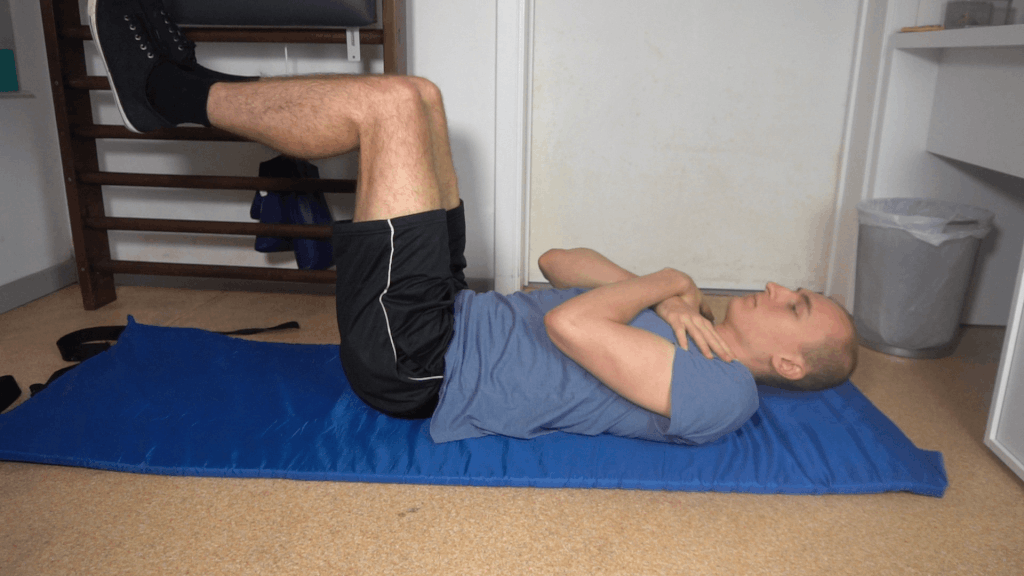For certain people and situations, modifying an exercise can be worth it. Discover how to do knee crunches and what their benefits are.
Knee crunches, also known as straight elbow to knee crunch if you point your elbows forward, are a crunch exercise variation where you hold your legs in the air with 90-degree angles in your hips and knees instead of putting your feet on the ground.
The main benefit of this leg position is that some people will find it more comfortable than regular crunches.
One downside is that the range of motion of your ab muscles is likely slightly smaller. This is somewhat less optimal for working these muscles.
That being said, knee crunches can still offer great positive effects if you combine them with a good exercise routine. If you find it a lot more comfortable, you can still consider this variation.
How to do a knee crunch
If you are considering knee crunches for their extra comfort, you likely want to invest in something like a yoga mat too.
That being said, take the following steps to do a knee crunch:
- Lie down on your back. Raise your legs so that your hips and knees are at 90-degree angles. Keep your arms against your chest.
- Raise your shoulders as far as comfortable in a controlled motion. Keep your lower back against the ground and your neck in line with your upper body.
- Slowly lower your shoulders back to the ground.

Knee crunches are a relatively straightforward exercise.
The main thing to keep in mind is that you don’t want to swing your head forward. This can be uncomfortable and is not good in terms of exercise results.
Knee crunches muscles worked
The main muscles worked in knee crunches are your abs and more specifically the muscle fibers in the upper part.
You can also say your hip flexors and quadriceps have to work to a tiny extent to keep your legs in the position with two 90-degree angles.
Besides this, a difference with regular crunches is that your hips are likely tilted slightly back in the knee version.
This makes your abs go through a slightly smaller range of motion which is typically not good for training results.
That being said, you can still get nice amounts of muscle growth and strength progress from knee crunches if you implement good crunch exercise reps and sets and enough resistance.
This means about 3 to 6 sets of 6 to 25 (and even up to 50) knee crunches with a weight that makes these numbers very challenging.
If you need to use extra weight, you have a variety of weighted crunches to choose from.
Knee crunches benefits
Some people will find knee crunches more comfortable than the regular version.
Besides that, the positive effects of knee crunches will be very similar to the benefits of regular crunches. Some of these are:
- Stronger muscles: The knee crunch movement works your abs in a nice range of motion. In turn, this exercise can help you grow and strengthen these muscles.
- You could find them more comfortable: You may find the hip and spine position in knee crunches slightly more comfortable than the regular version.
- Makes your six-pack stand out more: By growing your ab muscles with knee crunches, you could make your six-pack stand out more. Keep in mind that your body fat percentage has to be low enough to see this benefit.
- No equipment or location required: Many people will find bodyweight knee crunches challenging enough. In turn, you don’t have to spend money on exercise equipment or time on driving to the gym.
- May reduce or prevent back pain: Making your abs stronger with knee crunches can help reduce or prevent back pain (1, 2).
Even though knee crunches are not completely unique in these benefits, the positive effects could convince you to do this exercise more often.
Knee crunch alternatives
Knee crunches can be a nice addition to ab workouts but you may want a bit more effectiveness or want to focus on different parts of your abs.
In these cases, you can also consider one of these knee crunch alternatives:
- Regular crunches
- Reverse crunches
- Cable crunches
- Ab wheel roll-outs
- Hanging knee raises
- Planks
- Lying leg raises
What knee crunch alternatives are the best for your situation depends on things like your goals, what your body can handle, the exercise equipment you have, etc.
Are knee crunches a good exercise?
Knee crunches can be a good exercise for working your ab muscles. Especially if you find it slightly more comfortable than regular crunches.
Keep in mind that the resistance training principles still apply. Make sure you do enough knee crunches and potentially do the movement with crunch exercise equipment to get to your goals.
At the same time, it is worth noting that knee crunches will typically involve a slightly smaller range of motion than regular crunches.
Since this is generally not optimal for training results, you likely want to stick to regular crunches if you find these comfortable enough.
FAQ
What are knee crunches good for?
Knee crunches are mainly good for making regular crunches slightly more comfortable for your hips and lower back. In turn, you give up a tiny amount of effectiveness.
